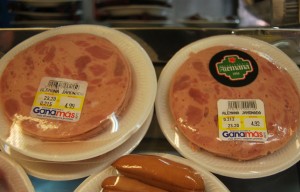Ham and the Imperial City

It is hard to imagine a breakfast list in Cuzco that does not include ham and eggs. Ham seem that omnipresent an that necessary, yet its existence in the Imperial city is strangely thin. It requires thought.
In Spain ham is a delight and a delicacy and the word jamón, or ham, has deep resonance as an image of how a woman’s hips should be. None of that seems to have made the crossing to Cuzco.
The Spaniards did introduce pork and pigs went native, obtaining an indigenous name khuchi, something almost no other European animal could claim. Pork is key to ceremonial and social life in Cuzco, whether as lechón, technically suckling pig but also a delicious pork roast, as chicharrón, chunks of deep fried and well seasoned pork, or as t’oqto, the crispy and airy pieces of deep-fried pork skin sold all over the city.
Yet the ham offered, with one exception, seems strangely vapid. It seems a blond joke of pork, commercially produced to have minimal flavor and lots of pink color. This is definitely not the jamón serrano of Spain hanging in long dark skinned haunches with a juicy pink interior.
Instead of being modeled on Spanish ham, the pink cured leg of pork came to Peru with the German immigration of the nineteenth and early twentieth centuries and it has spread throughout the country with the growth of modernization and urbanization.

Even the German version of Speck is different from this ham. This is the industrial version of a processed ham, not nearly Spam but still not the texture or richness of a slice from cured pork leg. There is not supermarket in the city that does not offer slices of ham from pressed, commercial loafs in the cold cut section. This is the ham that makes its way to breakfast tables in tourist restaurants throughout the city where it is stripped and scrambled with eggs.

This ham is as modern as Nescafé and would seem to have stepped right off the pages of an advertisement in Look of Life magazines from the fifties and sixties. You would almost expect to have the Jetsons suddenly appear on TV screens when this parody of meat is served.
Peru does have an indigenous tradition of making ham, one that goes to the Spanish invasion. This ham is called jamón del país, or country ham, though it is rare in Cuzco. Instead you find what is called lomo ahumado, or smoked loin. This is a brownish cured pork loin without pink dye.
It is flavorful and tasty, whether sliced and served with eggs or on bread as the filling of a sandwich. Compared to the industrial pressed ham, this is the difference between a wooden baseball bat which has a solid and resonant snap when it hits the ball and a plastic bat that strikes with a thud.
Despite its quality and flavor, this indigenous Peruvian ham is almost entirely absent from the tourist sector of Cuzco. You do find it in the committedly traditional Café Ayllu in either of its two locations (Almagro Street 133 by pollo a la brasa–rotisserie chicken restaurants or on Marques 263 where pedestrians can choose one of its two floors). This cafe fills with Cuzco’s middle and upper middle classes, far more than with tourists.
Here is where you find the autochthonous tradition of ham in the Imperial City. It is not Inca nor rural. It is solidly urban and tied to a life from before mass marketing and industrialization changed the German product and merchandised it throughout the country.
It is worth a visit to Cafe Ayllu to try this lomo ahumado along with traditional, Cuzco-style pastries such as a mother-in-law’s tongue (lengua de suegra) and old-fashioned Cuzco-style coffee.
In any case, ham of the pink consistent sort has made its place in Cuzco and it is hard to imagine a breakfast list without it, although the even newer import, bacon, is starting to give it a run for its money.





I can’t believe any one likes that processed so-called Peruvian ham product. I bought it once and had to throw it away as it reminded of the taste of SPAM. The only good hams in Peru are imported ones. Peruvians don’t know what they are missing.
For the record, John, I do not like the jamonada either.